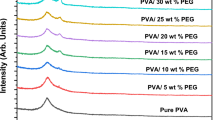Summary
The influence of ionic conductivity on the electrooptical response was investigated. A new monomer of 2-(poly(ethylene glycol)oxycarbonyl)-bicyclo[2.2.1] hepta-2,5-diene (PEGOC-BCHD) was synthesized and polymerized. Polymer/liquid crystal composite films are composed of poly(PEGOC-BCHD), E8, and alkali metal salts. The ionic conductivities were measured as a function of the ratio of LiClO4/ethylene oxide for various molecular weights of poly(ethylene glycol). The results indicate that the threshold field and response rise time can be reduced by increasing ionic conductivity of the matrix polymer. Liquid crystal droplets were observed in a continuous matrix phase in the form of ‘Swiss cheese’ morphology.
Similar content being viewed by others
Author information
Authors and Affiliations
Additional information
Received: 13 March 1998/Accepted: 19 May 1998
Rights and permissions
About this article
Cite this article
Kim, JB., Lee, MG. & Choi, JH. Effect of the ionic conductivity of a polymer matrix on the electrooptical properties of polymer-dispersed liquid crystal films. Polymer Bulletin 41, 37–43 (1998). https://doi.org/10.1007/s002890050330
Issue Date:
DOI: https://doi.org/10.1007/s002890050330




